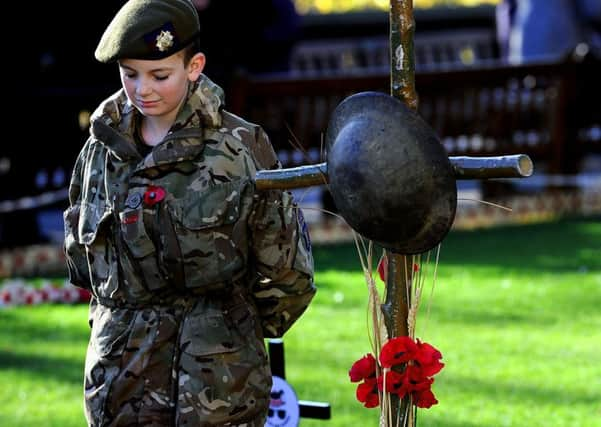Steve Cardownie: Real story behind poppy shows it doesn't glorify war


‘It was reported last week that one third of young people in the United Kingdom between the ages of 18 and 24 are reluctant to wear a poppy because they feel it “glorifies” war. Leaving aside questions about the accuracy of such a survey, it is clear that there has been a drastic failure on the part of their ‘seniors’ – be they parents, teachers, community leaders or journalists – to explain the origins of the Remembrance tradition.
‘There is – and never has been – any glory in the humble poppy. In December 1915 a poem appeared in Punch, the popular humorous magazine. In Flanders Fields was written on the front line in Belgium by a Canadian medical officer called John McCrae.
In Flanders fields the poppies blow
Between the crosses, row on row,
That mark our place: and in the sky
The larks, still bravely singing, fly
Scarce heard amid the guns below.
We are the Dead. Short days ago
We lived, felt dawn, saw sunset glow,
Loved, and were loved, and now we lie
In Flanders fields.
Take up our quarrel with the foe:
To you from failing hands we throw
The torch: be yours to hold it high!
If ye break faith with us who die
We shall not sleep, though poppies grow
In Flanders fields.
Advertisement
Hide AdAdvertisement
Hide Ad‘McCrae died in January 1918 and his words were forgotten – until an American magazine, The Ladies Home Journal, republished them shortly before the Armistice. Moina Michael, a young secretary employed in the New York offices of the YMCA, read the poem and took it as a personal challenge from McCrae and countless thousands of other soldiers who had passed the torch from their dying hands.
‘A conference was taking place that day. In gratitude for the effort she had made to brighten up the room with flowers, three of the delegates gave her a cheque for $10. She used the money to buy some red silk poppies, which she found at lunchtime in a local department store. When she returned to the office, delegates crowded round demanding poppies to wear.
‘Encouraged by this response, Moina began a crusade to promote the poppy as the United States’ official symbol of Remembrance. In spite of numerous setbacks, she finally persuaded the Georgia branch of the newly formed American Legion to adopt the flower in 1920 and a few weeks later the National American Legion ratified the decision.
‘That meeting was attended by Anna Guérin, a representative of the French YMCA. On her return to France, she founded the American and French Children’s League, organising women, children and disabled veterans to make artificial poppies out of paper and cloth.
Advertisement
Hide AdAdvertisement
Hide Ad‘These were then sold to the public with the proceeds directed to the restoration of devastated areas close to the old front line. In 1921, Anna visited the London headquarters of the newly formed British Legion and explained the fundraising potential of the little red flower. The rest is history.
‘Six million men served in the war. Nearly a million of them died and 1.75 million of them suffered some degree of disablement, of whom half were permanently disabled. The welfare state did not yet exist. Unemployment was high; widows and children of the nation’s dead heroes were living in poverty. The British Legion and The British Legion Scotland – the distinction is important – embraced the poppy, which has been worn ever since as a symbol of silent respect for those who gave their tomorrows for our todays.
‘The very act of Remembrance itself grew out of the Great War. The ceremony that we still recognise today was not designed. Like the poppy, it evolved from bud to bloom, then dying, to bloom again each year. Perhaps over time these events have become stuffy, dominated by representatives of the great and the good – both military and civilian. Perhaps, as we approach the centenary of the end of the war that was meant to end all wars, we should think about John McCrae’s challenge to the future: “If ye break faith with us who die, we shall not sleep.”
‘Do not break faith. Wear your poppy with pride – in memory of all the men and women from our cities, towns and villages who lie in Flanders Fields and every other bloody field. If we forget – if we forget to remember – we betray our honoured dead and we betray the very future of our children because as sure as night follows day, we will stumble into the same stupid mistake again.’
Tynecastle’s £130 brick
Advertisement
Hide AdAdvertisement
Hide AdDuring the lunch an auction was held with a number of lots up for grabs and a sizeable sum raised.
Perhaps the most surprising item was a brick from the now demolished stand at Tynecastle Park.
The successful bid was £130 making it a very expensive brick indeed and prompted the comment that even pieces of the Berlin Wall went for less!
I will be donating my fee for today’s column to the Trust as a thank you for Jack’s contribution.